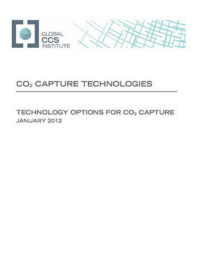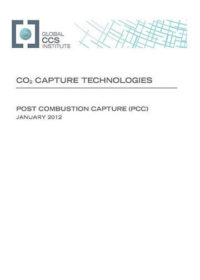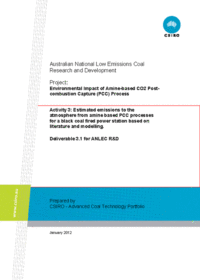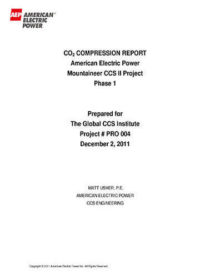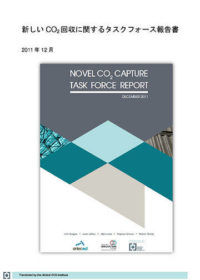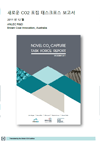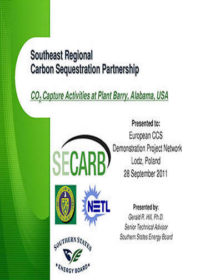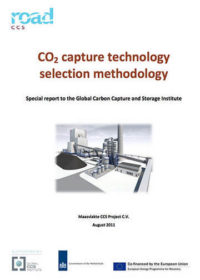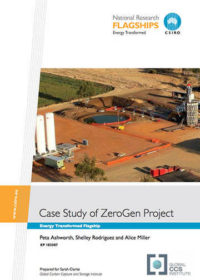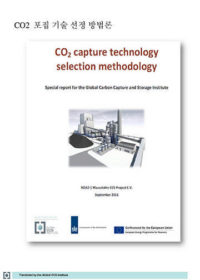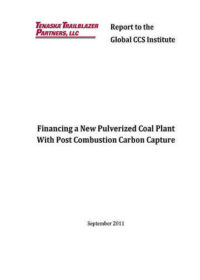Resources
Publications
Our publications, reports and research library hosts over 500 specialist reports and research papers on all topics associated with CCS.
View our Publication Library Disclaimer.
Filter by
CO2 capture technologies: technology options for CO2 capture
18th January 2012
Topic(s): Carbon capture use and storage (CCUS), CO2 capture
This is the first in a series of reports that provide detail on the various capture technologies, with a primary focus on the power industry. These reports appeal not only to technical stakeholders, but also to non-technical project people and other stakeholders responsible for regulation and funding of large-scale integrated projects. The reports have been developed by the Electric Power Research Institute (EPRI) for the Global CCS Institute.
By necessity, the reports have been split in terms of technology (post-combustion, pre-combustion, and oxy-combustion carbon capture), with a specific section examining each topic in detail. There is also an overview that provides an overall comparison, as well as background to allow stakeholders to interpret information in the different capture technology report sections.
Other key points raised in the overview are:
- Although current technology needs further improvements, it is extremely important to demonstrate CCS on a commercial scale as soon as possible. This is necessary for the demonstration of capture technology operating in an integrated mode in a real power plant and in a real power grid environment.
- Unless progress is made at the commercial CCS demonstration scale, it will become increasingly difficult to justify continued R&D funding on potential improvements to capture and storage technologies.
- If multiple CCS demonstrations with improved technologies are to be achieved at large scale by 2020 to proceed with commercial deployment, many technologies need to be approaching the pilot plant stage today.
- Thermal efficiency improvements in 'host' power plants (without carbon capture) offer an effective way to mitigate carbon emissions in their own right (2 per cent efficiency improvements result in a 5 per cent reduction in carbon emissions).
Disclaimer
The content within the Global CCS Institute Publications, Reports and Research Library is provided for information purposes only. We make every effort and take reasonable care to keep the content of this section up-to-date and error-free. However, we make no claim as to its accuracy, currency or reliability.
Content and material featured within this section of our website includes reports and research published by third parties. The content and material may include opinions and recommendations of third parties that do not reflect those held by the Global CCS Institute.
CO2 capture technologies: post combustion capture (PCC)
18th January 2012
Topic(s): Carbon capture use and storage (CCUS), CO2 capture
This report provides an update for post-combustion carbon capture in the power industry.
Post-combustion capture refers to the separation of CO2 from flue gas derived from combusting fossil fuels – coal, natural gas, or oil – in air. Some key points raised in the post-combustion carbon capture report include:
- The exclusive emphasis is currently on absorption (into solvents) on near-term technologies, reflecting the fact that industry’s CO2 capture chemistry knowledge and overall process experience are both heavily slated towards absorption.
- The major challenges in post-combustion capture revolve around the relatively large parasitic load CCS imposes on a power plant, the majority of which is due to capture, especially the energy needed to regenerate the solvent.
- Development of new chemistry, new process designs and novel power plant integration schemes all aimed at reducing the parasitic load of CCS are the focus of virtually all R&D in post-combustion capture.
- In general, capital cost reductions, solvent degradation, solvent volatility and other such parameters are secondary to the prime issue of reduction in parasitic load on the host power plant imposed by the process itself.
Disclaimer
The content within the Global CCS Institute Publications, Reports and Research Library is provided for information purposes only. We make every effort and take reasonable care to keep the content of this section up-to-date and error-free. However, we make no claim as to its accuracy, currency or reliability.
Content and material featured within this section of our website includes reports and research published by third parties. The content and material may include opinions and recommendations of third parties that do not reflect those held by the Global CCS Institute.
Estimated emissions to the atmosphere from amine based PCC processes for a black coal fired power station based on literature and modelling
1st January 2012
Topic(s): Carbon capture use and storage (CCUS), CO2 capture, Health safety and environment
Disclaimer
The content within the Global CCS Institute Publications, Reports and Research Library is provided for information purposes only. We make every effort and take reasonable care to keep the content of this section up-to-date and error-free. However, we make no claim as to its accuracy, currency or reliability.
Content and material featured within this section of our website includes reports and research published by third parties. The content and material may include opinions and recommendations of third parties that do not reflect those held by the Global CCS Institute.
CO2 compression report. American Electric Power Mountaineer CCS II Project: Phase 1
2nd December 2011
Topic(s): Carbon capture use and storage (CCUS), CO2 capture
The study focused on commercially available, integrally-geared, inter-cooled, gas compression systems. The scope included all of the equipment required to compress and condition the captured CO2 for sequestration. Geologic characterisation information and actual operating data from the Mountaineer Chilled Ammonia Product Validation Facility (PVF), which operated from 2009 to 2011, provided injection parameters on which to base the design for the commercial-scale compression system. Equipment arrangements, auxiliary power demands, balance of plant integration, and capital and operating costs were considered in the evaluation of each compression system.
In the end, two arrangements were considered technically and economically feasible for implementation on the commercial-scale system. Further technical investigation in Phase II of the project would determine which arrangement would ultimately be selected. Both utilise compression of the CO2 to an intermediate condition, followed by variable-speed pumping to the final desired injection conditions. The compressor-pump arrangement allows for greater flexibility and higher operating efficiency throughout the life of the well, which is important based on the expected variability in injection pressure over the life of the injection wells – a key takeaway from the PVF operation effort, and design basis driver for the commercial-scale project.
Disclaimer
The content within the Global CCS Institute Publications, Reports and Research Library is provided for information purposes only. We make every effort and take reasonable care to keep the content of this section up-to-date and error-free. However, we make no claim as to its accuracy, currency or reliability.
Content and material featured within this section of our website includes reports and research published by third parties. The content and material may include opinions and recommendations of third parties that do not reflect those held by the Global CCS Institute.
新しいCO2回収に関するタスクフォース報告書
1st December 2011
Topic(s): Carbon capture use and storage (CCUS), CO2 capture
CO2 排出削減に関する各政府目標達成には、複数の低炭素技術のメニューが必要となる。オーストラリアでは、天然ガスの使用が増大しているが、発電の大部分は石炭によって行われている。オーストラリアではこれまで化石燃料から排出されるCO2 の地中貯留の検討に注力してきた。今般地中貯留に代わるCO2 回収貯留の方法を検討するために、この調査を実施する作業部会が開催された。本調査では、CO2 の生物的隔離(bio-sequestration)および鉱物的隔離(mineral sequestration)といった新規技術を調査し、いくつかの提言を行っている。
Disclaimer
The content within the Global CCS Institute Publications, Reports and Research Library is provided for information purposes only. We make every effort and take reasonable care to keep the content of this section up-to-date and error-free. However, we make no claim as to its accuracy, currency or reliability.
Content and material featured within this section of our website includes reports and research published by third parties. The content and material may include opinions and recommendations of third parties that do not reflect those held by the Global CCS Institute.
정부의 CO2 배출 감축 목표를 달성하기 위해서는 저탄소 기술 포트폴리오를 개발해야 한다. 호주의 전력 에너지 대부분이 석탄을 이용하여 생산되고 있으며, 천연가스 사용이 점차 늘어나고 있는 추세이다. 호주에서는 이러한 화석연료로부터 배출되는 CO2의 지중 저장에 관하여 대대적으로 연구하고 있다. 이 연구는 지질학적 저장의 대안 수단으로서 CO2 포집 및 저장을 조사하기 위해 BCIA, ANLECR&D, GCCSI의 지원 하에 수행되고 있다. 태스크포스(Task Force)에 의해 발견된 새로운 CO2 포집 기술 분야는 바이오 분리 및 미네랄 분리이며, 그 정의는 다음과 같다.
Disclaimer
The content within the Global CCS Institute Publications, Reports and Research Library is provided for information purposes only. We make every effort and take reasonable care to keep the content of this section up-to-date and error-free. However, we make no claim as to its accuracy, currency or reliability.
Content and material featured within this section of our website includes reports and research published by third parties. The content and material may include opinions and recommendations of third parties that do not reflect those held by the Global CCS Institute.
CO2 capture activities at Plant Barry, Alabama USA
28th September 2011
Topic(s): Carbon capture use and storage (CCUS), CO2 capture
Disclaimer
The content within the Global CCS Institute Publications, Reports and Research Library is provided for information purposes only. We make every effort and take reasonable care to keep the content of this section up-to-date and error-free. However, we make no claim as to its accuracy, currency or reliability.
Content and material featured within this section of our website includes reports and research published by third parties. The content and material may include opinions and recommendations of third parties that do not reflect those held by the Global CCS Institute.
CO2 capture technology selection methodology
23rd September 2011
Topic(s): Carbon capture use and storage (CCUS), CO2 capture, Engineering and project delivery
ROAD stands for ‘Rotterdam Opslag en Afvang Demonstratieproject’ (Rotterdam Capture and Storage Demonstration Project) and is one of the largest integrated demonstration projects in the world for the capture and storage of CO2.
In this report, the selection methodology developed by the ROAD project team is described and evaluated, starting with the request for proposal for preliminary studies and ending with the final selection of the capture plant supplier. This report aims to help other CCS projects using post-combustion capture technology to design their own capture plant supplier selection methodology. In a broader sense, it is envisioned that other CCS projects or projects involving novel technologies can learn from the analysis provided in this report.
With respect to the capture supplier selection approach, the most prominent requirement introduced by this funding program was adherence to the challenging project schedule. As the development and construction of the capture plant are on the critical path of the project schedule, the project team had to find a way to select a capture plant supplier within the given time constraints, while still respecting other important constraints, such as cost, technical performance and health, safety and environment (‘HSE’) performance. For this reason, the project team developed a tailor made CO2 capture technology selection methodology.
This report is the first in a series of seven. Other knowledge sharing reports and case studies to be released in the coming months will cover a wide range of topics including: permitting, stakeholder consultation, commercial and funding arrangements, as well as the FEED study for the capture facility for the ROAD project.
Disclaimer
The content within the Global CCS Institute Publications, Reports and Research Library is provided for information purposes only. We make every effort and take reasonable care to keep the content of this section up-to-date and error-free. However, we make no claim as to its accuracy, currency or reliability.
Content and material featured within this section of our website includes reports and research published by third parties. The content and material may include opinions and recommendations of third parties that do not reflect those held by the Global CCS Institute.
Case study of ZeroGen Project
20th September 2011
Topic(s): Carbon capture use and storage (CCUS), CO2 capture
This report is one of a series of case study reports undertaken by CSIRO as part of an international comparison of communication and engagement practices surrounding carbon dioxide capture and storage (CCS) projects funded by the Global CCS Institute. The ZeroGen Project is a Queensland Government initiative established to develop, construct and operate an Integrated Gasification Combined Cycle (IGCC) and carbon dioxide capture and storage (CCS) power plant and storage facility in Central Queensland, Australia. The project’s goal is to sequester 60 million tonnes of CO2 waste gases over the lifetime of the project to assist in reducing Australia’s greenhouse gas emissions. Carbon dioxide will be sourced from the yet to be constructed 400 MW power generation facility. This case study seeks to provide insights into stakeholder perceptions of past and present communication and engagement practices conducted by ZeroGen in relation to its IGCC with CCS project in Central Queensland.
Disclaimer
The content within the Global CCS Institute Publications, Reports and Research Library is provided for information purposes only. We make every effort and take reasonable care to keep the content of this section up-to-date and error-free. However, we make no claim as to its accuracy, currency or reliability.
Content and material featured within this section of our website includes reports and research published by third parties. The content and material may include opinions and recommendations of third parties that do not reflect those held by the Global CCS Institute.
Rotating equipment for carbon dioxide capture and storage
16th September 2011
Topic(s): Carbon capture use and storage (CCUS), CO2 capture, CO2 storage
This study was commissioned to examine the type of compression machinery currently available for this duty, to look at novel compression concepts and investigate the options for integrating the compression train into the overall process.
Disclaimer
The content within the Global CCS Institute Publications, Reports and Research Library is provided for information purposes only. We make every effort and take reasonable care to keep the content of this section up-to-date and error-free. However, we make no claim as to its accuracy, currency or reliability.
Content and material featured within this section of our website includes reports and research published by third parties. The content and material may include opinions and recommendations of third parties that do not reflect those held by the Global CCS Institute.
Disclaimer
The content within the Global CCS Institute Publications, Reports and Research Library is provided for information purposes only. We make every effort and take reasonable care to keep the content of this section up-to-date and error-free. However, we make no claim as to its accuracy, currency or reliability.
Content and material featured within this section of our website includes reports and research published by third parties. The content and material may include opinions and recommendations of third parties that do not reflect those held by the Global CCS Institute.
Financing a new pulverized coal plant with post combustion carbon capture
1st September 2011
Topic(s): CO2 capture, Project financing
Tenaska, in its role as developer, will be responsible for obtaining financing for the project. Tenaska has raised approximately US$11.4 billion in aggregate financing, including US$4.7 billion in bank facilities, US$3.0 billion in capital market transactions and US$3.7 billion in corporate facilities.
This report discusses the issues associated with financing the Trailblazer project. Although a detailed discussion of the revenue gap currently facing the project was provided in the Global CCS Institute report entitled Bridging the Commercial Gap for Carbon Capture and Storage dated July 2011, a recap will be provided in this report. This report also discusses the financing considerations this and other large carbon capture and storage (CCS) projects will face, as well as factors that can mitigate financing risks. Finally, the report outlines Tenaska’s plan for financing the project.
Disclaimer
The content within the Global CCS Institute Publications, Reports and Research Library is provided for information purposes only. We make every effort and take reasonable care to keep the content of this section up-to-date and error-free. However, we make no claim as to its accuracy, currency or reliability.
Content and material featured within this section of our website includes reports and research published by third parties. The content and material may include opinions and recommendations of third parties that do not reflect those held by the Global CCS Institute.
